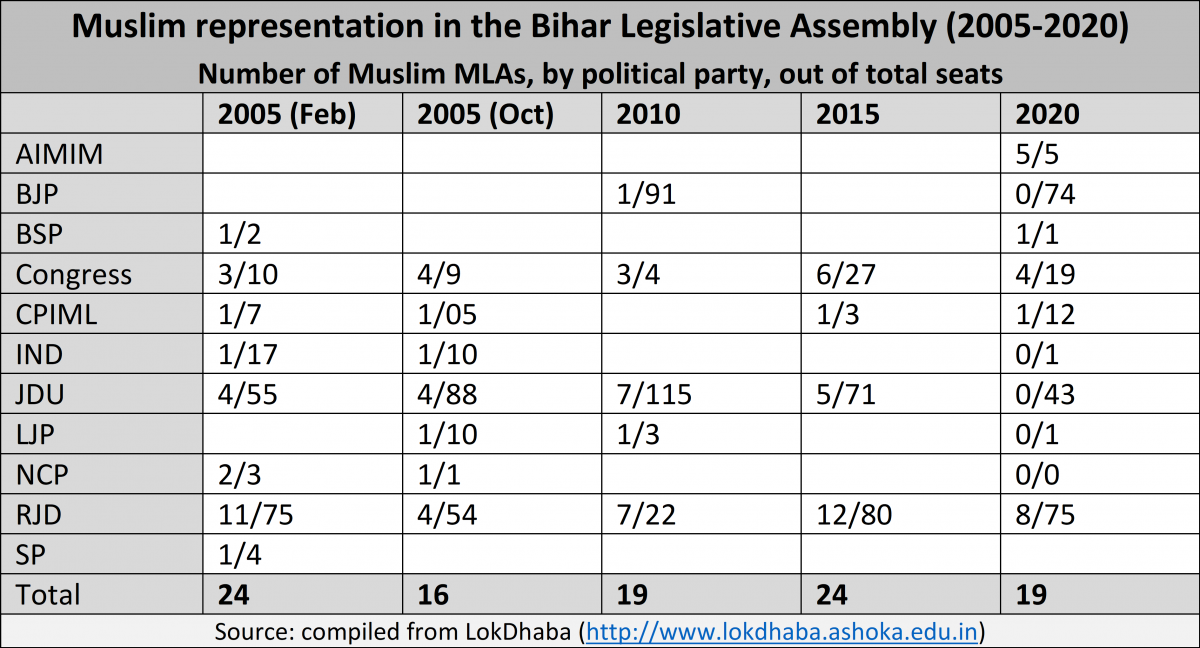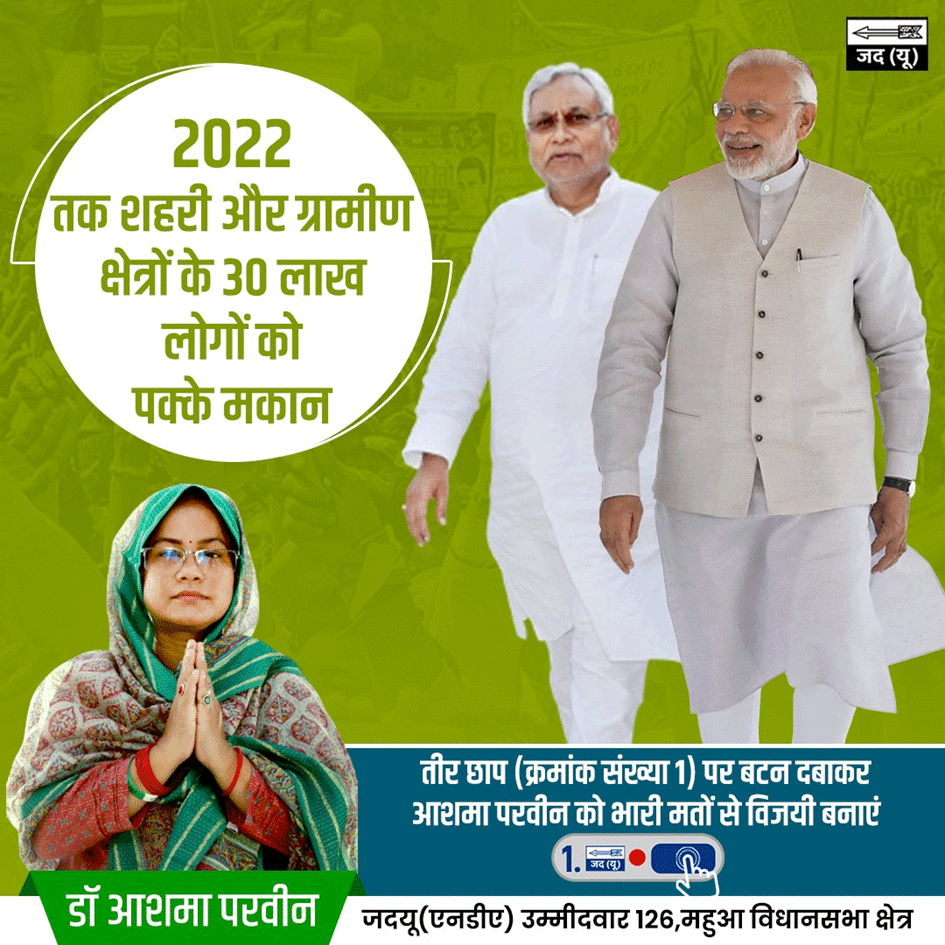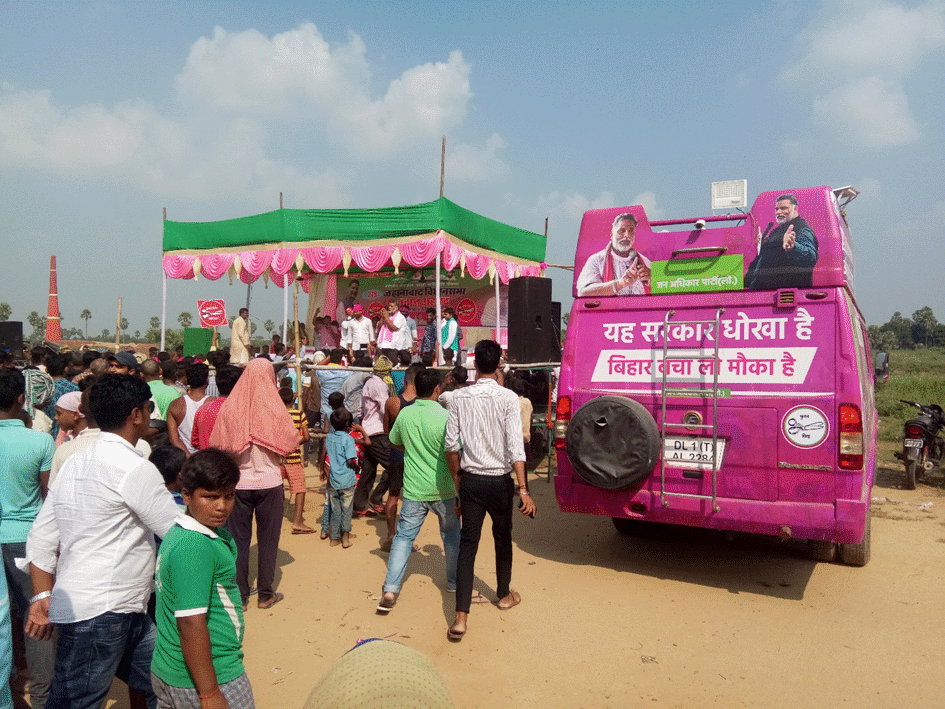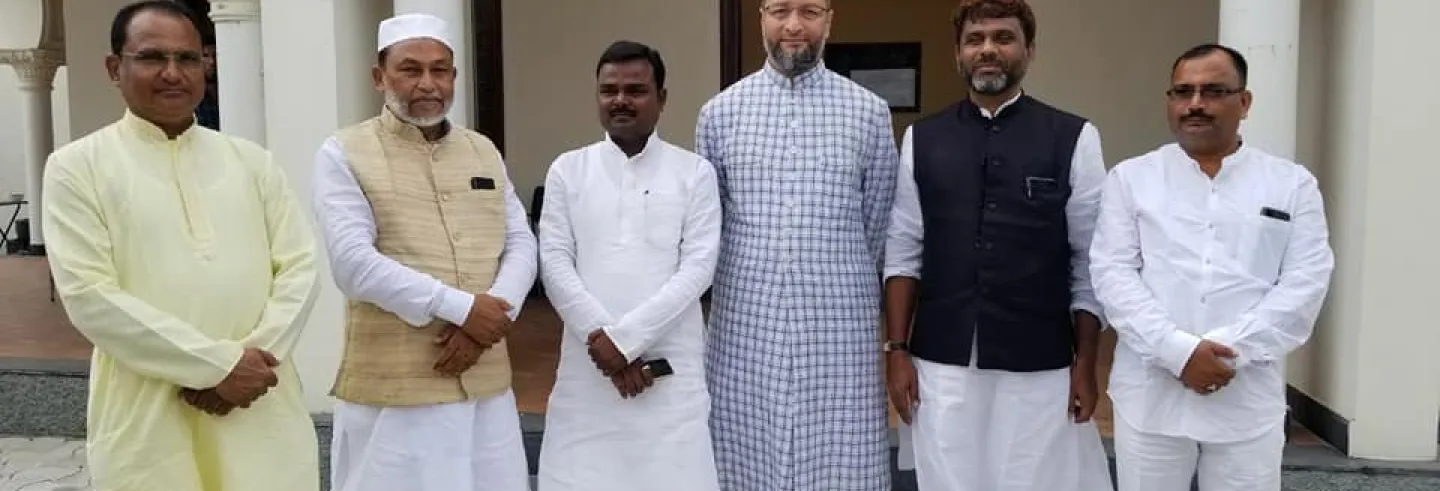In the final outcome of the Bihar assembly elections, what drew attention to some of the successful Muslim candidates was the fact that the All India Muslim Ittehad-ul Muslimeen (AIMIM) won five seats in the north-eastern Seemanchal region, where Muslims form about half of the population (from 77.5% in Jokihat to 38% in Araria).
However, the AIMIM’s MLAs represent less than a third of the 19 Muslims who were elected to the assembly this year. This shows that there is more to Muslim political participation in Bihar than the AIMIM’s breakthrough. This article offers a typology of the forms of political dynamics among Muslims in Bihar — the basic idea being that Muslim political dynamics are different in minority and majority areas.

Muslim (majority) politics: The AIMIM’s foray in Seemanchal
When looking at Muslim political participation in Bihar, one of the interesting characteristics of the state is that it includes both Muslim minority and majority (or near-majority) areas. This leads to two distinct political dynamics. In areas where they are not in a majority, Muslims seem subject to a kind of minority syndrome and thus more concerned with security than with collective assertion. In the Muslim majority areas, on the other hand, a space opens up for ‘Muslim politics’, that is, a political discourse that stresses the need for Muslims to be politically represented on their own terms and to voice community-specific concerns. The AIMIM’s and Asaduddin Owaisi’s politics fall into this category. Owaisi explicitly states the need for ‘Muslim politics’, as for instance in this interview: “The realization among Bihar Muslims and everywhere is that we require an independent political voice.” This worked well this time in Seemanchal, where in 13 constituencies Muslims account for at least 40% of the population. Yet Seemanchal is not new to Muslim politics. Syed Shahabuddin, the editor of Muslim India and a prominent voice on ‘Muslim issues’ — from the Shah Bano case to the destruction of the Babri Masjid — had for instance won the Lok Sabha seat of Kishanganj in 1991.
While the AIMIM has made its entrance in Bihar in the latest elections, its candidates are also not new to politics, but are professional politicians. The party’s anti-BJP rhetoric that invoked the charged atmosphere of the anti-Citizenship (Amendment) Act (CAA) protests fostered wide popularity among Muslim youth. Yet the comfortable margins the AIMIM achieved in the five constituencies it won — Amour, Kochadhaman, Jokihat, Baisi and Bahadurgunj — could hardly have been possible without candidates with political experience.
[T]he local standing of candidates was crucial for the AIMIM’s victories in Bihar.
The main organizer of the AIMIM in Bihar, Akhtarul Iman — who won in Amour with a margin of 52,000 votes — had been a Rashtriya Janata Dal (RJD) MLA between 2005 and 2014. The winner in Bahadurganj, Anzar Naeemi, had been candidate on a RJD ticket in 2010 and joined the AIMIM only in August 2020. In Jokihat, the contest was a family affair. Shahnawaz Alam, the son of eight-time MLA and one-time MP Muhammad Tasleemuddin, was contesting against his elder brother, Sarfaraz Alam of the RJD, who had been elected three times to the assembly seat (with the RJD in 2000 and then the Janata Dal (United), or JDU, in 2010 and 2015) and once to a parliamentary seat in a by-election (with the RJD in 2018). In Baisi, Syed Ruknuddin Ahmad had previously won as an independent in 2005 and had later joined the JDU. And in Kochadhaman, the winner, Muhammad Izhar Asfi, had been a panchayat mukhiya (head) and an old associate of Akhtarul Iman. Asfi also happened to unseat his own son-in-law, four-time Congress MLA Tausif Alam.
Thus, the local standing of candidates was crucial for the AIMIM’s victories in Bihar — combined with the popularity of Asaduddin Owaisi and Akhtarul Iman, and, in some places, a subtle balance between local dominant communities. The AIMIM had to appeal to Seemanchal’s two largest social groups among Muslims. The Surjapuris — considered to be Shaikh and therefore part of the dominant Ashraf cluster — are in large numbers in Kishanganj district, while the marginalized Kulhaiya — who were included in the category of Extremely Backward Classes created by Nitish Kumar’s government in 2005 — constitute a significant group in Araria district. The AIMIM’s winning candidates hail from the numerically dominant community of their respective constituencies: Surjapuri Shaikh for Akhtarul Iman, Anzar Naeemi, and Izhar Asfi in Kishanganj and Purnia districts, and Kulhaiya for Shahnawaz Alam in Araria district. To help the AIMIM candidates win over the Kulhaiya vote, Shahnawaz Alam campaigned with them in their constituencies. Finally, the AIMIM’s fifth MLA, in Baisi, is a Sayyid — the highest social group among Muslims that claims descent from Prophet Muhammad — whose family has long been integrated with the Surjapuri environment.
In none of the constituencies where the NDA won and the MGB came in second place did the AIMIM obtain a vote share greater than the winning party’s margin.
The AIMIM’s rise in Seemanchal attracted media attention and much condemnation from the Congress party and the RJD. The role of ‘kingmaker’ that some analysts expected the party to play did not materialize — the AIMIM’s five seats were not enough to help the Mahagathbandhan (MGB) form a majority, were it indeed to join the alliance. Yet accusations of the AIMIM being responsible for the MGB’s failure to win enough seats to form the government were repeatedly expressed. The allegation, however, does not hold upon closer analysis. In none of the constituencies where the National Democratic Alliance (NDA) won and the MGB came in second place did the AIMIM obtain a vote share greater than the winning party’s margin. In other words, the fact that the AIMIM contested these seats did not siphon off enough votes from the MGB to be responsible for its defeat.
The more elaborate construction of the ‘vote katwa’ (vote cutting) or ‘BJP ki B team’ (BJP’s B team) allegation targets Owaisi’s rhetoric of Muslim politics and questions his commitment to secularism and democracy.
In spite of the AIMIM’s past and the occasional radical actions of some of its members … the party’s popularity and electoral successes in recent years do not rest on a radical discourse but operate within the framework of electoral democracy.
On the night of the election results, Congress spokesperson Pawan Khera held that Owaisi’s politics spark radicalization among Muslim youth by seeking to counter the BJP’s radical discourse. Khera spoke of a “mutually reinforced radicalization” that makes Owaisi a “partner with right-wing radicalization”. This idea blames Owaisi for participating in Hindu-Muslim polarization on an equal footing with the BJP, supposedly contributing to bolstering politicians with majoritarian claims and side-lining the potential weight of Muslim voters. Yet this accusation confusingly blends two processes: radicalization and polarization. In spite of the AIMIM’s past and the occasional radical actions of some of its members (Akbaruddin Owaisi’s Karimnagar speech of 2013 or the agitation against Taslima Nasreen in 2007), the party’s popularity and electoral successes in recent years do not rest on a radical discourse but operate within the framework of electoral democracy.
However, the question of polarization deserves more discussion. One might indeed wonder whether the AIMIM’s Muslim politics pushed Hindu voters towards the NDA in the 20 constituencies where the AIMIM was contesting. One observation may seem to indicate so: in the 32 constituencies where Muslims form at least 30% of the population, the BJP increased its MLA representation from seven in 2015 to 12 in 2020, winning five new constituencies. Yet, even if a consolidation of the Hindu vote could be ascertained, the causality with the AIMIM’s politics remains unclear, as the BJP has gained new seats in area with little Muslim population as well. Besides, couldn’t this polarization be the result of the long-term political work of other parties and candidates, whether in the NDA or the MGB?
Muslim minority politics: What worked for other winning Muslim candidates?
The AIMIM’s entrance into Bihar politics may be an important step in the party’s expansion beyond its stronghold of Hyderabad. However, as much as it wants to claim representation for all Muslims, in Bihar the AIMIM is responsible for the victory of only five out of a total of 19 Muslims who were elected to the assembly (down from 24 in 2015). This shows that in most of Bihar, where on average Muslims make up about 17% of the population, candidates are unlikely to be elected with a rhetoric of ‘Muslim politics’, because they need to appeal to non-Muslim voters as well. This is true even in constituencies where the Muslim population is above the state average, such as in Madhubani and Dharbhanga districts (where Muslims number more than 30% of the population in several constituencies). In minority areas, even if the AIMIM’s popularity may help its losing candidates stand a few percentage points ahead of the rest — as in Sikta, where the AIMIM candidate won 5% of the votes — its rhetoric cannot place the party in the winning position.
What appears clear from the fate of Muslim candidates is the unambiguous vote against the NDA. None of the 11 Muslim candidates fielded by the JDU were able to win, even in seats with a high Muslim population, such as Sheohar. As a result, the ruling coalition does not count a single Muslim MLA in its ranks.
Muslim voters identified the JDU not so much as a Bihar-based party that is able to deliver on governance, but as an alliance breaker and an ally of the BJP…
The JDU’s Muslim candidates, whether in Seemanchal (Araria, Thakurganj, Kochadhaman, and Amour) or elsewhere (such as Sikta, Dharbhanga rural, and Marhaura, or Mahua), all came second or third. The JDU’s five Muslim MLAs in the previous assembly who contested this election also lost. Seats where Muslim JDU candidates had won in 2015 thanks to the RJD-JDU alliance now went to the MGB candidates (Sheohar, Sikta, Thakurganj) or the AIMIM (Jokihat, Kochadhaman). This points to the fact that Muslim voters identified the JDU not so much as a Bihar-based party that is able to deliver on governance, but as an alliance breaker and an ally of the BJP. The anti-NDA stance of Muslim voters also shows in the fact that the Lok Janshakti Party (LJP), which tried to project itself as an ally of the BJP and an opponent of the JDU, could not get any of its seven Muslim candidates elected.
Among all parties, the RJD retains the largest number of Muslim MLAs (eight, down from 12 in 2015), suggesting that its Muslim-Yadav equation still works efficiently. The party successfully placed Muslim MLAs in five seats where previously a non-Muslim was the incumbent (three from the JDU, one BJP and one independent), and won one constituency from a JDU Muslim MLA. Yet, interestingly, only two of the RJD’s eight Muslim MLAs elected in 2020 are incumbents, which means that the party also lost many constituencies with an incumbent Muslim MLA: eight such seats went to the NDA. While three sitting RJD Muslim MLAs were defeated in their own constituencies, the party incurred the loss of an important figure, Abdul Bari Siddiqui, and could not successfully fill the void left by the death of its four-time MLA Abdul Ghafoor.

The Congress seemed to pursue its long-term association with Muslim elites, by picking candidates who tend to be Ashraf, well-educated, with links with educational centres such as Aligarh Muslim University (AMU) or Jawaharlal Nehru University (JNU), New Delhi. The only Congress Muslim candidate from a marginalized Muslim community was Abidur Rahman in Araria, a seat with a strong Kulhaiya presence, and he was re-elected. The Congress had fielded 12 Muslims among its 70 candidates, a higher proportion than other parties. Yet, its candidates were often directly pitted against the BJP rather than the smaller parties, in part explaining its low strike rate. For instance, in the former RJD constituency of Jale, the Congress fielded Mashkoor Ahmad Usmani, a former president of the AMU student’ union. Usmani got more than 65,000 votes (38%) but could not defeat the BJP candidate. However, the Congress’ three incumbent Muslim MLAs showed striking stability and were re-elected.
Muslim identity politics: How does Pasmanda mobilization translate in electoral terms?
Our typology of political dynamics among Muslims is incomplete without mention of caste-based or identity politics.
Bihar stands out as a bastion of caste-based mobilization by marginalized Muslim groups. In particular, the Momin Ansaris, or weavers, have long had organizations working for their collective upliftment and access to politics, such as the Momin Conference, which opposed the Muslim League before Partition and was merged by its leader, Abdul Qayyum Ansari, into the Congress after Independence.
More recently, it is also in Bihar that such mobilization significantly re-emerged in a new form. New organizations now explicitly challenge the leadership of the Ashraf, accusing them of maintaining their dominant position by invoking the necessity for Muslims to unite as a minority community. In the mid-1990s, Ali Anwar launched the Pasmanda Muslim Mahaz, and Ejaz Ali established the Backward Muslim Morcha. While both claimed to represent the Pasmanda — marginalized caste-groups within Muslims — this bifurcation indicates an internal power imbalance: between the numerically larger and politically active Ansaris and the multiple other smaller biradaris (caste groups) who have been side-lined within Pasmanda movements. Yet in the 2000s, both Ali Anwar and Ejaz Ali accepted Rajya Sabha nominations by the JDU, which sought to pull Pasmanda support away from upper caste Muslim candidates fielded by the RJD and the Congress.
As the political campaign picked up momentum ahead of the 2020 Bihar elections, Pasmanda activists published online lists of the Muslim candidates that indicated their biradari. After the results, they were quick to point out the lack of caste diversity among Muslim candidates and elected MLAs. Not only is there a continued over-representation of Ashraf among Muslim candidates and elected MLAs (16 Ashraf against 3 Pasmanda this year), there are also very few biradaris represented of the total number of caste groups. Out of three Ansari candidates picked by the large parties (Anjum Ara of the JDU in Dumraon, Qayamuddin Ansarin of the CPI (ML) in Arrah, and Javed Iqbal Ansari of the RJD in Banka), none managed to emerge victorious.
Pasmanda politics has not so far proved itself to be an electoral force…the need to vote for a winning candidate against the NDA trumps any possible biradari affinity among Muslims.
The lack of political representation of the marginalized among the Muslims persists in spite of the creation in 2019 of a new organization that aimed to solve this issue. Invoking the heritage of Abdul Qayyum Ansari, the Ansari Mahapanchayat (AMP) was founded by a young Jamia Millia Islamia graduate from Gaya, Waseem Nayyar Ansari. The AMP’s message is clear and simple: Ansaris represent 11% of Bihar’s population but there is neither an MLA nor an MP from the community. The AMP argues for self-representation in proportion to their population share, as indicated by the slogans “apni qayadat, apni siyasat” (our leadership, our politics), “jiski jitni abadi, utni hissedari” (participation proportional to our population). The AMP launched a ground-level campaign to build a base in central and western Bihar which led to a large gathering in Patna in December 2019, attended by about 3,000-4,000 people and by prominent figures of Pasmanda politics, such as Ali Anwar and Dr. Ayyub, the head of the Peace Party.
Initially claiming to be entirely non-partisan and working exclusively as a lobby for the presence of Ansaris and Pasmanda Muslims, the AMP took a political stand when it opposed the CAA-NRC and joined the Bihar Bandh on 15 December 2019. The AMP hoped to be able to negotiate for as many as 30 or 40 tickets, but its discussion with Congress and RJD fell short of its expectations. It eventually joined the Progressive Democratic Alliance led by Rajesh Ranjan, the veteran politician better known as Pappu Yadav. In fact, the AMP leadership split at that point, with a section accepting the JDU’s promise of Legislative Council seats while Ali Anwar and his Pasmanda Muslim Mahaz expressed support for MGB.

This shows the limits of such caste-based organizations. While they may offer a way of creating a political base for a leader, they are undermined by individual opportunity seekers. They are dependent on the support of larger political organizations to enter the electoral contest, but are often too weak to weigh in on major parties’ arbitrations.
The AMP fielded five Ansari candidates in the elections, who received between 1,000 and 3,500 votes. In spite of this poor performance, one might argue that being able to enter an alliance with a well-known personality, field several candidates from the community, and gain the following of several thousand people, was quite a step for a new initiative. Nonetheless, Pasmanda politics has not so far proved itself to be an electoral force. In the minority context, the need to vote for a winning candidate against the NDA trumps any possible biradari affinity among Muslims.
Conclusions
If the 2020 Bihar election did about bring some changes to minority politics, other long-standing trends are still at work in the shaping of state-level politics. The AIMIM’s push on the basis of a rhetoric of Muslim politics is significant but does not tell the whole story. The RJD’s Muslim-Yadav equation is still efficient. The Congress still seeks to co-opt Muslim elites. In spite of recent mobilizations, Pasmanda politics has not been able to make a dent in electoral dynamics but can be a good way for someone with political ambitions to enter the political arena. Finally, the overarching voting trend among Muslim voters, whether in majority or minority contexts, or among marginalized Muslim communities, remains a strong will to defeat the candidates of the BJP and its allies.









